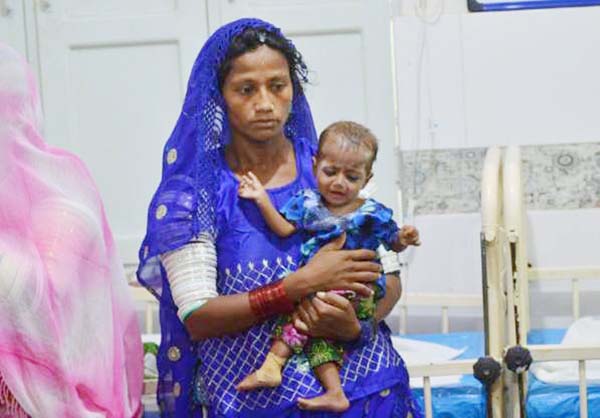
AFP, Karachi :
A frantic mother cradling her seven- month-old baby rushes towards the special paediatric ward in a desolate Pakistan town, his eyes are blank and he is smaller than most newborns.
He is starving in a country that has no shortage of food, but which has one of the highest infant mortality rates in the world and where malnutrition is rife.
The infant weighs just 2.5 kilograms – the average for a healthy child of that age is almost three times that.
His case is not unique for the doctors at the Mithi Civil Hospital in hunger-stricken Sindh province where millions survive on less than $1 a day.
Of the 150-250 patients who come in each day, roughly one fifth are suffering from malnutrition, Dr Dilip Kumar, head of the paediatric department, tells AFP.
Inside the ward, nine other malnourished infants are crying inside glass incubators. A young mother, Nazeeran, clutches the hand of her toddler.
“Her weight is dropping, even though we consulted many doctors,” the 25-year-old says.
The International Food Policy Research Institute (IFPRI), a poverty and hunger watchdog, estimates around one in five of Pakistan’s more than 200 million people are malnourished.
And yet, the nation is not short of food – in fact, according to the US Department of Agriculture, it is projected to export 500,000 tons of wheat from May 2018 until April 2019, and 7.4 million tons of rice in the same period.
Dawn, the English-language daily newspaper, even reported a potato glut earlier this month.
·The issues, experts say, are socio-economic – that is, just because food
is available, does not mean people can access it.
“There are four key pillars of food security in Pakistan: The first is availability, then accessibility, utilisation and stability,” says Dr Ambreen Fatima, senior research economist at the Applied Economic Research Centre of the Karachi University.
In Tharparkar, where Mithi Civil Hospital is, all four are lacking, she explains, adding that in other parts of the country they are present only to varying degrees.
“Pakistan is quite well off in wheat production,” comments Dr Kaiser Bengali, a veteran economist, who has done field research on poverty and hunger in the country, but adds that much of it is sold for export.
This means ordinary people in the country may not have access to it, and if they do they may not have the resources to pay for it.
“Affordability is the biggest challenge here in Pakistan,” he says.

